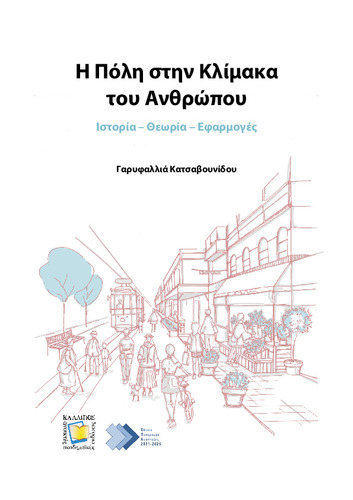| Title Details: | |
|
The City at Human Scale |
|
| Other Titles: |
History – Theory – Applications |
| Authors: |
Katsavounidou, Garyfallia |
| Subject: | ENGINEERING AND TECHNOLOGY > TECHNOLOGICAL SCIENCES AND ENGINEERING > REGIONAL AND URBAN PLANNING > METROPOLITAN SPATIAL PLANNING ENGINEERING AND TECHNOLOGY > TECHNOLOGICAL SCIENCES AND ENGINEERING > REGIONAL AND URBAN PLANNING > URBAN DESIGN ENGINEERING AND TECHNOLOGY > TECHNOLOGICAL SCIENCES AND ENGINEERING > ARCHITECTURE > HISTORY OF ARCHITECTURE AND URBANISM ENGINEERING AND TECHNOLOGY > TECHNOLOGICAL SCIENCES AND ENGINEERING > ARCHITECTURE > LAW AND SOCIAL SCIENCES > ANTHROPOLOGY (NON PHYSICAL) > SOCIAL AND CULTURAL ANTHROPOLOGY > URBAN ANTHROPOLOGY |
| Keywords: |
Urban design
City planning Public spaces Sustainable urban mobility Design principles Public life studies Human-centered urbanism Observational study History of the city Social approach of urban space Psychology and space Anthropocene City and climate change |
| Description: | |
| Abstract: |
Τhe city is the most complex and intricate human artifact and at the same time our everyday environment. The physical form and the management of the urban environment greatly determines people’s everyday life and health, social relations, and economic growth in cities, as well as the future of humanity on our planet. Therefore, urban design interests all of us, both experts and laymen . The main theme of this book is how urban design can improve people’s lives , through the adoption of the humanistic approach in the entire spectrum of design scales, from strategic planning to the microscale design of physical space. It is articulated in ten chapters, in which the reader is acquainted with the history, the theory and the practical applications of the human-centered approach in urban design. Each chapter corresponds to an autonomous lecture and includes various learning activities (discussion points, in-class exercises, videos etc.), following Diane Laurillard’s theory of six learning types. The book also focuses on public spaces, as a field of study of urbanism and as a field of practice of urban design, and at the same time it emphasizes on their importance for sustainable urban development. It presents the history of the city through the lens of the human scale, the genealogy of the social approach in urbanism, with an emphasis on observational studies of public space, and it elaborates on the philosophy of human-centered design, mainly through Jan Gehl’s concept of “life between buildings”. Using case studies and best practice examples, it proposes basic design principles for human-centered public spaces and urban streets. It puts emphasis on ecological thinking, which is an indispensable part of the humanistic design approach, especially today, as we face the consequences of catastrophic human intervention on ecosystems and of anthropogenic climate change.
|
| Linguistic Editors: |
Triantari, Maria |
| Graphic Editors: |
Oikonomou, Evangelia |
| Other contributors: |
Yiannakou Athena, (writer of preface), Professor Emerita
AUTH |
| Type: |
Undergraduate textbook |
| Creation Date: | 05-04-2023 |
| Item Details: | |
| ISBN |
978-618-5726-76-8 |
| License: |
Attribution - NonCommercial - ShareAlike 4.0 International (CC BY-NC-SA 4.0) |
| DOI | http://dx.doi.org/10.57713/kallipos-199 |
| Handle | http://hdl.handle.net/11419/9309 |
| Bibliographic Reference: | Katsavounidou, G. (2023). The City at Human Scale [Undergraduate textbook]. Kallipos, Open Academic Editions. https://dx.doi.org/10.57713/kallipos-199 |
| Language: |
Greek |
| Consists of: |
1. The concept of “the city at human scale” 2. The history of the city from the dawn of civilization to the 18th century 3. The history of the city from the Industrial Revolution to World War II 4. The city after World War II: Functionalism, suburbanization, and the critique of the Modern Movement 5. The human-centered tradition in the study of urban public space 6. Jan Gehl’s philosophy for the life between buildings 7. Basic principles for human-centered design of spaces for gathering and recreation 8. The human-centered approach to urban mobility 9. Basic principles for human-centered design of urban streets 10. Urban design in the era of the Anthropocene |
| Number of pages |
336 |
| You can also view | |
| User comments | |
There are no published comments available! | |

